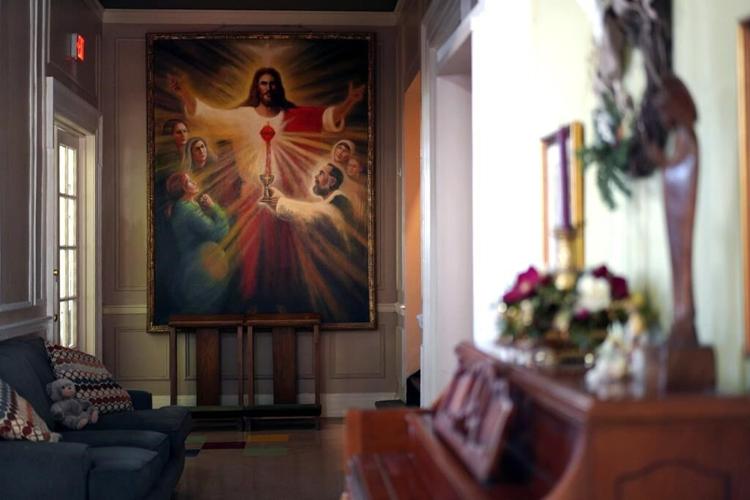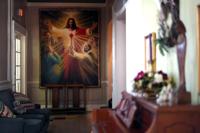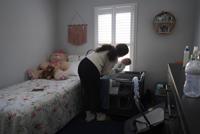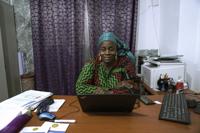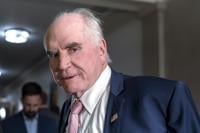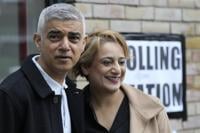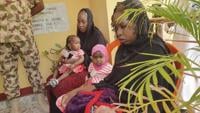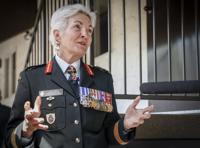ORANGE, Va. (AP) — On the wall of the maternity home is the motto: “Saving Babies, One Mom at a Time.”
For founders Randy and Evelyn James, the home started with one baby — their own.
Paul Stefan was the last of their six children, born with a fatal condition. They had not aborted the pregnancy as doctors advised. He lived just over 40 minutes, long enough to be baptized and named after their Catholic priest.
In the nearly two decades since, the Jameses have channeled their son’s memory and their anti-abortion beliefs into running maternity homes. Evelyn James said they knew they “were going to do something for women in crisis pregnancies.”
In August, their Paul Stefan Foundation plans to open a new floor with seven more rooms at their headquarters in a former hotel in Orange, Virginia.
Their momentum is part of a larger trend: There has been a nationwide expansion of maternity homes in the two years since the Supreme Court overturned and the federal right to abortion.
“It’s been a significant increase,” said Valerie Harkins, director of the Maternity Housing Coalition, an anti-abortion network of 195 maternity homes that has grown 23% since the court’s ruling.
There are now more than 450 maternity homes in the U.S., according to Harkins; many of them are faith-based. want to open more of these transitional housing facilities, believing they are the next step in helping women who carry pregnancies to term.
The reasons for the surge in interest in maternity homes are complex and go beyond abortion restrictions. Harkins said unaffordable housing, paychecks cut by inflation and higher birthrates in some states have all contributed.
“It created a perfect storm,” she said. “There’s quite a need.”
A Painful Legacy
The heyday of American maternity homes came during the three decades before Roe, when more than 1.5 million infants were surrendered for adoption during the “Baby Scoop Era.” Many unwed pregnant women were sent to maternity homes, where they were often coerced into relinquishing their babies.
“Our children were stolen,” said Karen Wilson-Buterbaugh, who lived in a Washington, D.C., maternity home in 1966.
When residents returned to their hometowns without a baby, they were supposed to pretend as if nothing happened.
But few could forget.
“It’s a mother losing her child,” said Ann Fessler, who collected oral histories from Baby Scoop Era mothers in her book, “The Girls Who Went Away.”
Fessler said, “The women, especially the ones that did not feel like they had a part in the decision, live with this trauma the rest of their lives.”
Harkins said the Maternity Housing Coalition takes ownership of this history.
“We are very intentional about what happened and want to ensure we don’t get to that point again,” she said.
Most residents in modern maternity homes choose to keep their children. They are there to receive housing and financial support.
There are homes, though, that continue to prioritize adoptions – which can still result in painful outcomes.
Abbi Johnson was 17 in 2008 when her parents sent her to Liberty Godparent Home, founded by the late evangelical leader Jerry Falwell. The Lynchburg, Virginia, home was connected to an adoption agency.
From a conservative Christian family, Johnson felt her unplanned pregnancy was treated as “the most cardinal sin,” but she still desperately wanted to parent her son.
“But everyone told me this isn’t playing house," she said. “He’s not a doll. He deserves a married couple who has their life together.”
The home said in a statement that every resident is educated on parenting and adoption “and has the freedom to choose.”
In the end, Johnson felt pressured into placing her son for adoption. She hopes one day he might know how much she misses him.
“Half my head resides in that maternity home,” she said, “playing the memories again and again and again.”
“Where can I live with this baby?”
Before she moved into a maternity home, Meryem Bakache considered an abortion.
Newly arrived in the United States from Morocco, Bakache spoke little English and lived in a crowded apartment with family in northern Virginia while her husband attended college.
“Where can I live with this baby?” she recalled thinking. “What can I give him? I don’t have nothing.”
Without health insurance, she looked for medical care and found an anti-abortion counseling center — often called a crisis pregnancy center — which provided her with an ultrasound.
“When I see my baby, just like everything changed,” she said.
Through a friend, she found , a maternity home in Fredericksburg, an hour east of the Paul Stefan home.
Many homes receive referrals from similar centers, which exist to divert women from getting abortions. The Maternity Housing Coalition, to which both Paul Stefan and Mary’s Shelter belong, is a project of Heartbeat International, a large association of .
Holding her infant son this winter, Bakache described her relief at seeing the beauty of the quaint blue home where Mary’s Shelter assigned her to live.
Her housemate Jasmine Heriot had also been looking for a safe living space before the birth of her second child. She lost employment and housing after a life-threatening first pregnancy and premature birth.
“Everything was just so clean. The room was all set up,” Heriot said.
Across the country, maternity homes are sprouting up. In Nebraska, an old college campus is becoming maternity housing. In Arizona, a home has added to one property and opened another. In Georgia, lawmakers recently made it easier to open maternity homes.
Mary’s Shelter also recently expanded by opening another house. Like the Jameses, founder Kathleen Wilson was inspired by her Catholic and anti-abortion beliefs to begin the ministry, which includes more than 30 bedrooms in six houses and four apartments.
She is aware the anti-abortion movement is often derided as championing only unborn children, but she thinks maternity homes are one answer to that criticism.
“They defy that lie that we only care about the baby in the womb,” she said.
Finding a Village
Danielle Nicholson lived at for almost five years. She is one of its success stories, now raising a soon-to-be sixth grader.
But she had arrived as a surly 20-year-old, six months pregnant and feeling abandoned. “You don’t end up in a maternity home because you have a big, huge, loving village of a family,” she said.
Evelyn and Randy James became and remain like parents to her. “Women are not numbers here. Or case files,” she said.
She found not everyone was well-suited for the facility or parenthood, though.
“Living with the not-so-fantastic moms put something in my heart,” Nicholson said. “Like I need to help. How do I help women not create abused and neglected children?”
It inspired her to become a social worker after she finished college.
Her time as a case worker for vulnerable families has complicated her views of the anti-abortion movement, even though it’s foundational to the maternity home that did so much for her.
“My heart was really broken when Roe v. Wade was overturned,” she said later.
She didn’t choose an abortion, and still wouldn’t. But she doesn’t judge those who do.
Abortion is “one of those choices that women have to face every day, for whatever reason,” she said. “There’s grace for those women too.”
___
Associated Press religion coverage receives support through the AP’s with The Conversation US, with funding from Lilly Endowment Inc. The AP is solely responsible for this content.

